Reading Fiction Can Be Fun, But It Isn’t Enough To Boost Achievement
Teenagers who read a lot of fiction do better on international reading tests, according to a recent study. But that doesn’t mean we can boost achievement just by encouraging kids to read more fiction.
It’s well established that kids who read a lot generally do better in school. But there hasn’t been much research on whether it matters what they’re reading. A recent study, drawing on data from over 250,000 15-year-olds in 35 industrialized countries, claims to have found a “fiction effect.” After controlling for a range of factors, the researchers found that students who read a lot of fiction for pleasure did significantly better on a standardized reading test than their peers who frequently read newspapers, magazines, nonfiction, or comic books. The test included not only passages drawn from fiction but also some nonfiction. The researchers speculated that the experience of reading novels develops students’ ability to sustain attention, allowing for reflection and deep thought rather than superficial skimming.
On the surface, the findings appear to support a widespread belief among teachers that just getting kids to spend time reading books of their own choice, often fiction, is the key to boosting reading ability and overall achievement. This is essentially the theory that undergirds our prevailing approach to reading instruction, with a couple of modifications. (One is that students need to be practicing comprehension “skills” and strategies while reading books of their choice. The other is that their choices must be restricted to books they’re presumed to be able to read easily on their own.) It’s certainly an alluring concept: learning can be not only effortless but totally pleasurable. Unfortunately, as evidenced by declining reading scores and a widening gap between higher- and lower-performers, the theory is seriously flawed.
As the authors of the recent study acknowledge, their data shows only correlation, not causation. Maybe teenagers who are avid fiction readers already have a greater capacity for sustained attention than their peers, and that explains why they’re able to lose themselves in a novel—and score higher on reading tests.
But let’s assume there is a “fiction effect.” Speaking as a former teenager who read a lot of novels, I would say kids in that category find reading largely effortless. The kids who don’t choose to read much fiction—or anything else except maybe comic books—probably find reading a struggle. Maybe they never got a chance to master the foundational reading skills that would enable them to read fluently and sound out unfamiliar words quickly. Maybe they haven’t had a chance to acquire the sophisticated general knowledge and vocabulary that would allow them to understand the words and concepts used in many novels. Maybe both.
That calls into question the researchers’ recommendation that we simply encourage young people to read fiction—especially “boys from disadvantaged socio-economic backgrounds,” who they say are least likely to read it. To be sure, all students should have an opportunity to read books of their choice, including fiction. But it’s going to be hard to convince those who struggle with reading to engage in that activity for “pleasure.” And even if they’re required to read a lot of books independently at school, it’s unlikely to significantly boost their reading ability. If kids read only simple text, they never get the chance to become familiar with the sophisticated vocabulary, syntax, and concepts that could enable them to understand increasingly complex text—no matter how much they read.
There’s one possible way around this problem: have struggling readers listen to more complex novels being read aloud by expert readers—like teachers. One small-scale study found that this approach enabled readers who were a year or more behind to make enormous progress. After just 12 weeks of listening to two novels being read at a fairly fast pace, those students made 16 months of progress on a comprehension test that included both fiction and nonfiction passages. (It made no difference, by the way, whether their teachers were trained in comprehension strategies.)
So whether or not there’s a “fiction effect,” we need to do more than encourage struggling readers to pick up a novel. We need to introduce them to the pleasures of reading by enabling them to listen to stories they can’t yet read easily on their own. We need to use the power of narrative to expand their knowledge of the world. And we need to prepare them to wrest meaning from text that doesn’t provide a storyline. Yes, that will involve effort. But that’s what real learning generally requires.
Want to Level Up Your Comprehension Teaching?
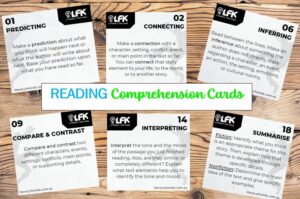
Student Comprehension Cards
Are your students easily confused when reading texts on their own? Try using these critical thinking questions to scaffold their understanding.
You can use them with whole-class reads when students are asked to read a portion of the text independently. They also work well with independent reading programs, including literacy circle and book club models.
Older students need scaffolding when reading texts independently, and that scaffolding should come in various forms – not just annotation. When you use these turn-and-talk discussion task cards, you’ll get a better idea of what is confusing your students; therefore, you’ll be able to help them get back on track and comprehending the text more efficiently.
Reading comprehension strategies targeted in this product include predicting, connecting, summarizing, visualizing, inferring, questioning, analyzing, evaluating, and more.
Email us for your copy at info@literacyforkids.com.au
Attention Teachers: Indicators for Student Growth
In our discussions with educators, we found that they want tasks and measures to help assess the effectiveness of instruction, as well as clear criteria for mastery. This is why we created our latest report ~
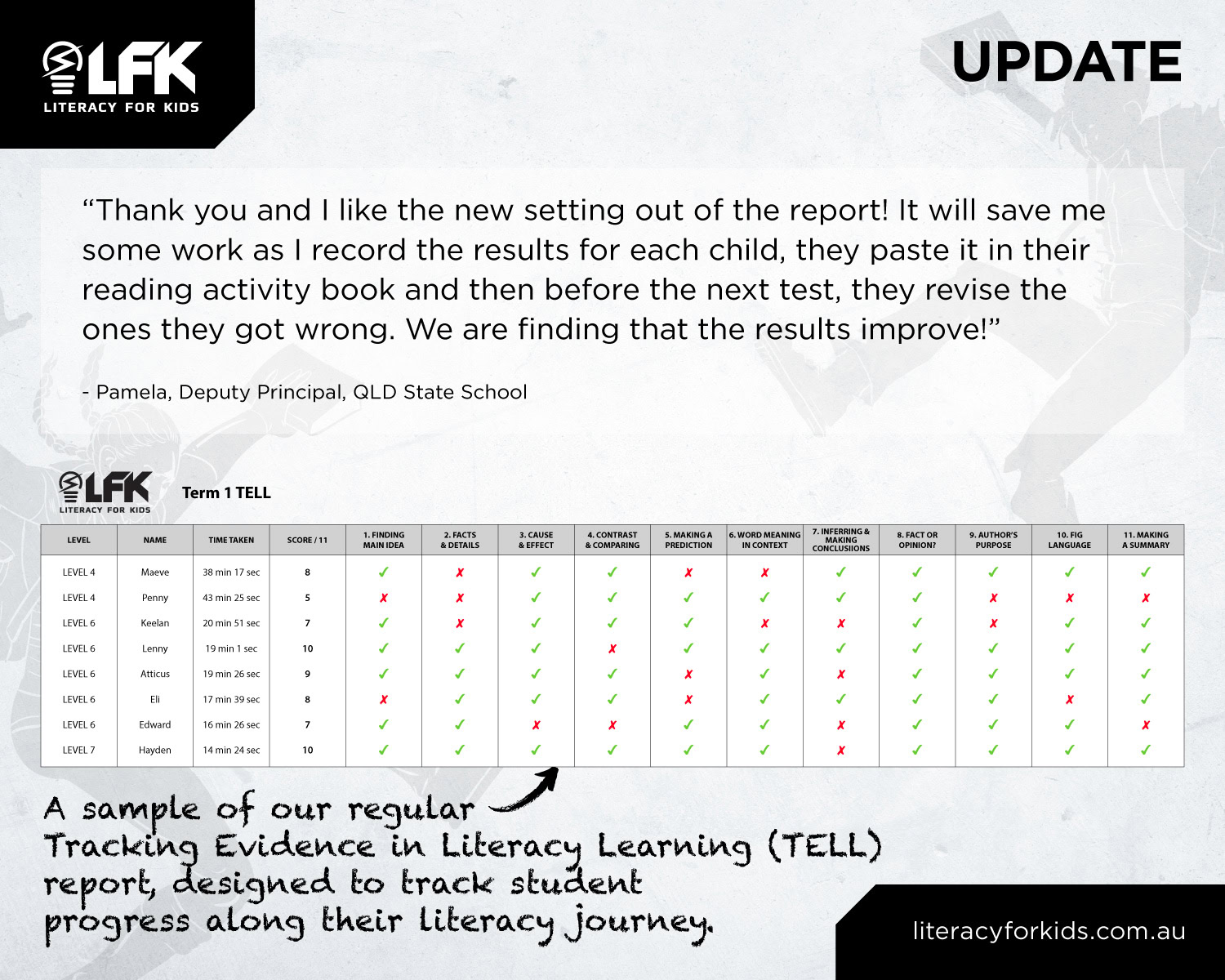
This report helps you to better judge not only if students are making progress, but also the rate at which students make progress (term-by-term comparison).
The Reading Comprehension texts are at the appropriate level and complexity that the student can read independently and show 11 specific comprehension skills/strategies.
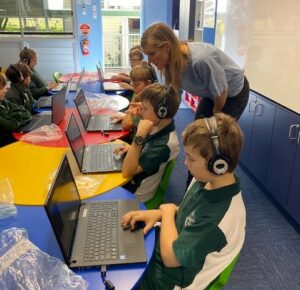 A successful literacy program’s content must be aligned with literacy outcomes. Literacy for Kids guarantees that your students work through engaging, quality content that focuses on essential skills in the core strands of literacy.
A successful literacy program’s content must be aligned with literacy outcomes. Literacy for Kids guarantees that your students work through engaging, quality content that focuses on essential skills in the core strands of literacy.Level Up Your Literacy Instruction
Teaching literacy is a skill. It takes a lot of time, practice, and effort to be good at it. This article will show you how to level up your literacy instruction and make a massive impact with your students, all while keeping them engaged!
A Reading Framework: think of it as a steel cable
Our students come to us with different levels of ease for climbing the literacy ladder. What makes skilled readers comprehend so well? Let’s try to understand how several concepts need to work together.
I want you to envision a large thick cable. Consider that a cable is created by twisting smaller strands together. If you break these strands down, they have sub-strands and smaller strands.
Concerning reading, the cable is made up of strands of reading and when woven together, they help strengthen and reinforce the reader.
How do we strengthen these strands for our readers?
Let’s look at the 2 main strands of reading: language comprehension and word recognition.
a) For students to be proficient with word recognition, they need to have phonological awareness, which includes sound manipulation, rhyming and understanding of syllables. They have to have decoding skills, which again has to do with spelling/sound correspondences. They also need to have sight word recognition.
b) For students to have language comprehension, they need to have background knowledge, vocabulary, an understanding of language structures (including syntax), verbal reasoning (for eg. inferencing) and literacy knowledge (ie text structure and genre).
The above highlights the interconnectedness of the complexity of reading. Visualising these elements woven together gives us a roadmap for teaching comprehension.
A plan of action
How can we figure out the best way to support a student? What should I focus on? Let’s look at a few strategies ~
- Ensure that students have strong word recognition skills, as it’s going to be ineffective for us to support them with just comprehension if they don’t have the tools to read the words.
- Consider the background knowledge when teaching comprehension. A student might show good word recognition skills, but if they’re missing background knowledge they will likely struggle to comprehend what they’re reading.
- Sentence structure is important. If students cannot understand how words and phrases work together to create meaning, they will struggle to pull meaning from that sentence.
It’s important to stress that these are not a checklist, instead, they are woven together to form that reading cable. We are constantly weaving the strands of word recognition with language comprehension, word recognition with language comprehension over and over.
Want to Level Up Your Comprehension Teaching?

Student Comprehension Cards
Are your students easily confused when reading texts on their own? Try using these critical thinking questions to scaffold their understanding.
You can use them with whole-class reads when students are asked to read a portion of the text independently. They also work well with independent reading programs, including literacy circle and book club models.
Older students need scaffolding when reading texts independently, and that scaffolding should come in various forms – not just annotation. When you use these turn-and-talk discussion task cards, you’ll get a better idea of what is confusing your students; therefore, you’ll be able to help them get back on track and comprehending the text more efficiently.
Reading comprehension strategies targeted in this product include predicting, connecting, summarizing, visualizing, inferring, questioning, analyzing, evaluating, and more.
Email us for your copy at info@literacyforkids.com.au
Attention Teachers: Indicators for Student Growth
In our discussions with educators, we found that they want tasks and measures to help assess the effectiveness of instruction, as well as clear criteria for mastery. This is why we created our latest report ~

This report helps you to better judge not only if students are making progress, but also the rate at which students make progress (term-by-term comparison).
The Reading Comprehension texts are at the appropriate level and complexity that the student can read independently and show 11 specific comprehension skills/strategies.
 A successful literacy program’s content must be aligned with literacy outcomes. Literacy for Kids guarantees that your students work through engaging, quality content that focuses on essential skills in the core strands of literacy.
A successful literacy program’s content must be aligned with literacy outcomes. Literacy for Kids guarantees that your students work through engaging, quality content that focuses on essential skills in the core strands of literacy.Positive experiences around reading: 8 helpful tips for teachers and parents
I am frequently asked, “How can I improve my child’s writing?” or “How can I improve my child’s understanding of maths?” You might be surprised to hear that I often suggest reading is the fundamental skill that can help to develop knowledge in other areas of the curriculum. Time and time again I see students who are great at practical maths but fall down in problem solving.
Cultivating a positive experience around reading is, in my opinion, one of the most crucial steps we can take to give our children the best start in education.
Some children may struggle at first to discover a love of reading, many other children drop reading and others just aren’t motivated to read. Let’s look at 8 ways to motivate children to read – we’ve aimed this at readers of all ages and abilities and for both teachers and parents.
1. Ask students to complete a timeline of their own experience with reading
You might introduce this by saying: “When I was little I loved listening to my mum read The Hobbit. Then for a short time, I stopped enjoying reading, but that was mostly because I found it difficult to find books that I liked. After a while, I discovered some interesting non-fiction books about The Bermuda Triangle and I was keen to read again. Then in high school, I was influenced by reading the classic To Kill a Mockingbird. Now as an adult I always make time to read each day, I share book titles with friends and follow my favourite authors on social media.”
You can draw this timeline for your students/children, mapping out the peaks and troughs associated with the different stages of a reading journey. We want kids to understand that their journey is important, as learning to read is not a simple, straightforward task. There will be highs and lows and at times they will struggle. Tell them that together you will find out the best ways to help them stay inspired with reading.
2. Set a meaningful goal around reading
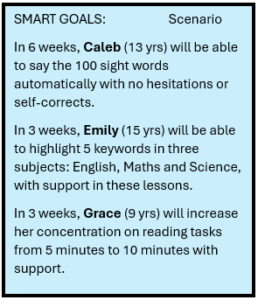 What are their future goals? Do they want to read a chapter per night? Encourage students to set Specific, Measurable, Attainable, Relevant, and Time-bound (SMART) goals. Guide them to think about their current reading abilities and identify areas where they can challenge themselves to grow. Emphasize the importance of setting goals that are realistic and aligned with their interests and aspirations. Working on SMART goals also provides greater opportunities for adults and students to work collaboratively. As the student achieves mastery of one SMART goal, they can contribute to setting the next mini-goal.
What are their future goals? Do they want to read a chapter per night? Encourage students to set Specific, Measurable, Attainable, Relevant, and Time-bound (SMART) goals. Guide them to think about their current reading abilities and identify areas where they can challenge themselves to grow. Emphasize the importance of setting goals that are realistic and aligned with their interests and aspirations. Working on SMART goals also provides greater opportunities for adults and students to work collaboratively. As the student achieves mastery of one SMART goal, they can contribute to setting the next mini-goal.
3. Why must it always be toilet-humour books?
I’ve been there with my kids and it drove me nuts: boys (& girls) who read and re-read the same type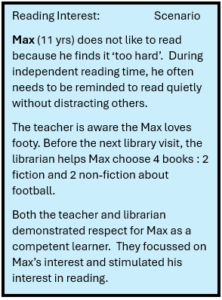 of book. My advice to teachers and parents is that you have to help kids out of this reading rut. As a parent or teacher, you will probably have 20 knockbacks of the books that you suggest but it might be book #21 that pushes them out of their comfort zone and onto new discoveries. Use your local library, borrow books from other friends/parents or send a message to the school librarian to help with suggestions. Don’t give up! Read the same books as them. Here’s my shared experience on ABC Radio of reading books about zombies (which is not my genre, but it reinvigorated my son’s interest in reading and was written by an amazing author of a great series). It’s so rewarding if you can get children onto a new author or series.
of book. My advice to teachers and parents is that you have to help kids out of this reading rut. As a parent or teacher, you will probably have 20 knockbacks of the books that you suggest but it might be book #21 that pushes them out of their comfort zone and onto new discoveries. Use your local library, borrow books from other friends/parents or send a message to the school librarian to help with suggestions. Don’t give up! Read the same books as them. Here’s my shared experience on ABC Radio of reading books about zombies (which is not my genre, but it reinvigorated my son’s interest in reading and was written by an amazing author of a great series). It’s so rewarding if you can get children onto a new author or series.
With school holidays approaching, try these book suggestions so they have reading material ~
4. “I don’t understand it!” Explicit instruction of comprehension
Students must be able to identify what they do understand and what they do not understand when reading text. Often a student will say “I don’t understand/It doesn’t make sense to me”, when in fact what the student means is that they don’t understand some parts of the text.
Teach students to become detectives and to look for clues that will lead to a better understanding or comprehension of text. Clues may include:
- headings and subheadings
- pictures, diagrams, illustrations
- keywords or phrases
Look at the content that precedes or follows for clues. What are the main ideas? Can you use your background knowledge? Can you identify the key main points/main facts?
** Many schools use our program for explicit instruction of these comprehension skills. Interactive whiteboards are brilliant for using Literacy for Kids or Literacy for Boys texts to go through key comprehension skills.
5. Use Social Media to connect with authors
The power of social media is phenomenal. I’ve used Skype to connect with authors and sometimes you might receive bookmarks and posters regularly. All questions on authorial intent could be answered by the person who actually wrote the book, which is hugely powerful. Authors love to communicate with children reading their book and it causes a really special connection for the children.
For older students, Instagram can be levered to follow authors, or other keen readers.
6. Attitudes to reading
Students who are struggling readers will usually say they ‘hate reading’. In essence, what they hate is being different from other students, feeling nervous, anxious or embarassed when asked to read, being labelled, not being able to complete their school work, finding ways to disguise their poor reading skills and struggling to perform academically. As students mature, this can become self-defeating: “I can’t read, so why bother?”
Use our visual questionnaire to engage students in examining their feelings about reading ~ this may be impacting their reading progress. LFK Reading Interest Survey Worksheet
7. Reading Aloud
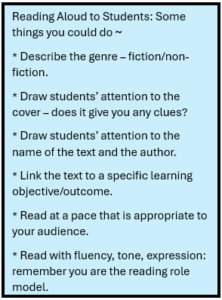 When teachers or parents read aloud, they are modeling fluency by demonstrating skills such as rhythm, phrasing, intonation, naturalness and use of voice for different characters/moods. When an adult reads aloud, they can stop and explore new words, investigate meaning and helps students to make connections with what they already know, think or understand.
When teachers or parents read aloud, they are modeling fluency by demonstrating skills such as rhythm, phrasing, intonation, naturalness and use of voice for different characters/moods. When an adult reads aloud, they can stop and explore new words, investigate meaning and helps students to make connections with what they already know, think or understand.
8. Independent Reading
The ultimate goal is to promote the habit of regular independent reading for pleasure. When we get our students to this point, they will select their own books and read about topics or subjects in which they are interested and that they enjoy. Where students independently choose books that are above their reading skills level, they can be supported to develop strategies – such as conferencing with other students – to overcome reading challenges.
Summary
Learning to read is a complex social and cognitive task that requires explicit, direct and sequenced instruction, daily practice and timely support. To be effective in supporting reading development, it is important to understand how reading develops and the strategies that can be used to support reading development. Reading programs can greatly assist teachers and parents but it is also important to build a repertoire of reading games, activities and modeling to create positive experiences around reading.
Want your students to finish strong in their literacy? Want more from your literacy program? Contact us for a 30-day free trial in your school or classroom. New schools receive this terrific Teaching Resource: 51 Writing Prompts. These are a complete hit with our schools and you will not be disappointed with these image-rich, kid-centred Writing Prompts that will enthuse your writers.
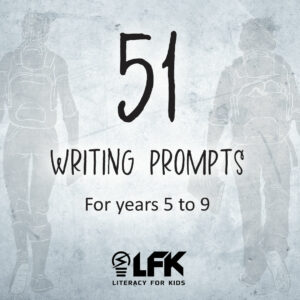



Check out our blogs for more ideas and tips.
Outstanding Results from School Using LFK and LFB
Resources for Reluctant Writers: in the classroom and at home
Track Each Boy’s Progress and Improve their Outcomes – Literacy for Boys Student Dashboard
7 Parent friendly tips for comprehension
Get boys reading in the digital age
What to do when your son hates reading – 6 top tips
Brought to you by Tanya Grambower

Explaining Reading: Inferring
#4. Inferring
Inferring is notoriously difficult for students. The data from our literacy programs consistently show that kids struggle with this concept.
Inferring is the ability to “read between the lines” or to “get the meaning” that the author implies, but does not state directly. No wonder our students find it tricky.
Inferring dominates virtually all comprehension because, to one extent or another, comprehension always involves trying to “get inside the author’s head” to see what he/she meant when the text was composed.
The student, operating from one set of background experience, cannot precisely know the mind of an author, who is coming from a different experience background. The reader must make a calculated guess as to the author’s meaning. Even when the author says something straightforward as “The car was blue,” the reader must infer the shade of blue, the make of the car and so on. So in this sense, virtually all comprehension requires some inference.
Therefore, inferring is a crucial comprehension strategy.
| Inferring is not done carelessly, and it is not wild guessing. Good readers use clues an author supplies plus their own background knowledge. |
How Will You Know You Need to Teach Inferring?
The situation: When discussing the text that has been read, you notice that students cannot answer questions about character traits, or mood or other information the author implies but does not state explicitly.
* Conceptual Understandings That Must Be in Place *Students need to understand:
|
So, what is the “secret” to doing it?
Students must:
- note the clues embedded in the text.
- access their own experience regarding these clues.
- make predictions about the implied meaning based on their experience with the clues provided by the author.
How do you know if your students are successful in this skill?
If after reading or listening to a story, students are able to answer questions that require comprehending what the author has implied but has not directly stated, and see if your students can describe the thinking they did to do such inferring.
Applying it to Writing
Students often understand inferring best if, during their own writing, they are encouraged to imply meaning. Consequently, when teaching to infer during reading, it is a great idea to plan writing sessions in which students are encouraged to insert into their own writing various kinds of implied meaning.
Inferring is essential to comprehension. Our programs Literacy for Kids and Literacy for Boys contain texts that require students to make connections, draw conclusions, or make predictions. When helping a student, pose open-ended questions that require students to infer answers. For example, instead of asking for a direct response, ask questions like “What do you think might happen next?” or “Why do you think the character made that choice?”
Want your students to finish strong in their literacy? Want more from your literacy program? Contact us for a 30-day free trial in your school or classroom. New schools receive this terrific Teaching Resource: 51 Writing Prompts. These are a complete hit with our schools and you will not be disappointed with these image-rich, kid-centred Writing Prompts that will enthuse your writers.




Check out our blogs for more ideas and tips.
Explaining Reading: #3 Imaging
Explaining Reading: #2 Monitoring and Questioning
Explaining Reading: #1 Predicting
7 Parent friendly tips for comprehension
Get boys reading in the digital age
What to do when your son hates reading – 6 top tips
Brought to you by Tanya Grambower

Explaining Reading: Imaging
#3. Imaging
A distinguishing skill of good comprehenders is that they respond to the descriptive text they read. They create pictures, or visual representations, in their minds.
Like so much of comprehension, imaging is something that good readers seem to do “naturally’. To these students, reading is like watching a movie ~ they use their imagination to create a mental representation of characters, settings, events, or concepts described in the text.
Imaging is one of the easier comprehension strategies to teach
Even young children respond to the idea that books are like tv shows and movies in that we should be trying to see and hear what is happening.
Imaging is very important to reading success because it is often the image that makes stories come alive. We want readers to see what the characters see, hear what the characters hear and feel what the characters feel. It is these emotional reactions that often “hook” students and cause them to think that reading is “cool”.
| If we can develop imaging, there is a good chance we can motivate students to make reading a permanent part of their lives. |
How Will You Know You Need to Teach Imaging?
The situation: Students listen to stories being read to them or read stories on their own but do not seem to be emotionally involved in what is happening.
* Conceptual Understandings That Must Be in Place *Students need to understand:
|
So, what is the “secret” to doing it?
Students must:
- Identify words the author is using that are descriptive.
- Use prior knowledge about those words and about our senses to create an image in the mind.
How do you know if your students are successful in this skill?
In listening situations, students should evidence greater emotional involvement in the stories. Students should give tangible indications of excitement, despair, sadness or scariness, depending on what is happening. Into the bargain, when asked, they should be able to describe verbally what they see and hear as they listen (or, for older students, when they read) and the thinking process they used to create the image.
Applying it to Writing
The relationship between reading and writing is particularly clear when teaching imaging. Students should apply their imaging strategy not only when listening and reading, but also when composing their own stories. During those writing opportunities, students should be encouraged to reverse the imaging process. Rather than thinking of imaging from the perspective of a reader trying to figure out what an author is trying to get us to see/hear/feel, students should be encouraged to think about it as a writer trying to get a reader to see or hear or feel.
The more kids practice writing text that helps readers create images, the more skilled they will be at creating images as readers. Our FREE resource for new schools (see below) is closely tied to this skill of imaging. The writing prompts are perfect!
Want your students to finish strong in their literacy? Want more from your literacy program? Contact us for a 30-day free trial in your school or classroom. New schools receive this terrific Teaching Resource: 51 Writing Prompts. These are a complete hit with our schools and you will not be disappointed with these image-rich, kid-centred Writing Prompts that will enthuse your writers.




Check out our blogs for more ideas and tips.
7 Parent friendly tips for comprehension
Get boys reading in the digital age
What to do when your son hates reading – 6 top tips
Brought to you by Tanya Grambower

Explaining Reading: Monitoring and Questioning
#2. Monitoring & Questioning
Comprehension is an active cycle of mental activity. Last week we discussed Predicting ~ but this is only the beginning process of seeking meaning. The cycle continues as students move into the text.
Basically, they monitor, question and, if necessary, they abandon the prediction they made earlier and form new predictions.
Monitoring and Questioning are the Strategic Heart of Comprehension
Monitoring is a process of talking to oneself about whether the meaning being encountered is the meaning anticipated – that is, “Is the prediction I made coming true?” Questioning is a process of talking to oneself about whether the meaning makes sense – that is, “Does this make sense? Is this what I had predicted was going to happen?“
Good readers seem to do it ‘naturally’, however struggling readers often operate under the falsehood that meaning will ‘come to them’ as they decode words.
| This cycle of thinking can be difficult to teach. Predictions are made then must be dismissed and replaced by new predictions. Finally, it takes energy – our students cannot coast along passively. |
How Will You Know You Need to Teach Monitoring, Questioning & Repredicting?
The situation: Students read orally without proper phrasing and intonation. When asked questions about their reading, they guess or do not answer at all.
* Conceptual Understandings That Must Be in Place *Students need to understand:
|
So, what is the “secret” to doing it?
Students must:
- Keep the original prediction in mind.
- Keep questioning whether that prediction continues to make sense as you read new information in the text.
- Use new information in the text and prior knowledge about that information to make new predictions.
How do you know if your students are successful in this skill?
Students will able to share the mental self-talk they did during reading. As an example, they will be able to describe where their monitoring caused them to pause and reconsider, the questions they asked themselves during reading and the times they needed to either modify a prediction or abandon it altogether and create a new one.
Applying it to Writing
This has a direct flow on effect. Students become better writers if they think about how they read. Their writing will make more sense if they are conscious of the monitoring-questioning-re-predicting cycle. After all, this thinking will help minimise the amount of questioning and re-predicting their readers will have to do!
Want your students to finish strong in their literacy? Want more from your literacy program? Contact us for a 30-day free trial in your school or classroom. New schools receive this terrific Teaching Resource: 51 Writing Prompts. These are a complete hit with our schools and you will not be disappointed with these image-rich, kid-centred Writing Prompts that will enthuse your writers.




Check out our blogs for more ideas and tips.
7 Parent friendly tips for comprehension
Get boys reading in the digital age
What to do when your son hates reading – 6 top tips
Brought to you by Tanya Grambower

Explaining Reading: Predicting
#1. Predicting
Predicting is fundamental to comprehension. Good readers anticipate meaning. They do this by predicting what they think is going to happen and by revising their predictions as they read.
Predicting is a skill for all ages – from emergent to high school readers
Emergent readers make predictions as they are listening to stories being read to them. More proficient readers make predictions when they are reading expository text. As a result, predicting can be taught to kids starting school and high schoolers, and it is appropriate in various genres of narrative text as well as various forms of expository text.
As with all comprehension strategies, predicting is based on the thoughtful use of prior knowledge. Readers may look at the pictures or the title or the headings to get an idea of what the topic is.
| This is why we feature short video clips in our program ~ aside from grabbing their interest, it provides students with topic clues to make predictions about the text. |
How Will You Know You Need to Teach Predicting?
The situation: Students keep on reading even when what they are saying no longer makes sense. When asked questions about what they just read, they are unsure.
* Conceptual Understandings That Must Be in Place *Students need to understand:
|
So, what is the “secret” to doing it?
Students must:
- Look for clues to the topic.
- Think about what they already know about the topic.
- On the basis of their prior knowledge, predict what they think will happen.
How do you know if your students are successful in this skill?
In follow-up reading, students will report that they made predictions and will state those predictions. When you ask them how they made their predictions, they should report the topic clues they were using and how they used their prior knowledge about each topic clue to figure out what might happen next.
Applying it to Writing
Remind students that when they write, they are authors. Authors provide topic clues the reader can use to make predictions about what is coming next. So, when they are writing, students should be conscious of the clues they are providing the reader.
Want your students to finish strong in their literacy? Want more from your literacy program? Contact us for a 30-day free trial in your school or classroom. New schools receive this terrific Teaching Resource: 51 Writing Prompts. These are a complete hit with our schools and you will not be disappointed with these image-rich, kid-centred Writing Prompts that will enthuse your writers.




Check out our blogs for more ideas and tips.
7 Parent friendly tips for comprehension
Get boys reading in the digital age
What to do when your son hates reading – 6 top tips
Brought to you by Tanya Grambower

Literacy Toolkit 2022: Some fresh ideas to inspire your students to read
What if every one of your students loved reading? It is a teacher’s most common worry: How do I inspire my students to read often and read well?
“The path of a reader is not a runway but more a hack through a forest, with individual twists and turns, entanglements and moments of surprise.” (John Holden, literacy author, 2004)
As a teacher and tutor with 20+ years’ experience (and mum of three: one an avid reader, one who reads occasionally and one who rarely reads!), it has always been my belief that individuals, especially boys, become better readers when they are engaged and supported by a culture that values reading. It’s not easy but worth the effort.
If you are looking to add an invigorating splash to your literacy program here are some strategies that you can start tomorrow:
1) Look at students’ attitudes, beliefs and perceptions related to their own reading
Does a student see themselves as a ‘reader’? Negative attitudes toward reading can be a huge roadblock in a classroom.
Use a survey as a tool to get to know your students. Download our LFB Reading Survey printable or you might try survey monkey. Another teacher used video to record ‘Reading Confessionals‘ – a format popularised by reality tv – and involved students speaking “privately” in front of a camera about themselves as readers. She set up a tripod in a corner of the classroom for filming. Using the iMovie app, you might like to ask 3 or 4 students to snip the clips into a “Reading Confessional Movie”. Kids love watching themselves on the big screen! An added bonus is that it contributes to your class’s collective culture and identity as readers. I also like this idea for the students who become anxious at public speaking in front of the whole class.
2) Turn Feedback into Action: find your “Launching Point”
Literacy gains will be a combination of persistence, practice and interest. Ideally, we want students to take ownership of their reading – now and into the future. From the surveys/interviews, you should have a grasp of the experiences and activities that motivate the student’s interest and what they enjoy. Now you have a “Launching Point” to encourage them into wanting to read.
Different students respond to different reward systems. Some kids just aren’t motivated by competing against others. So, I’ve compiled a range of ideas, initiatives and projects that might appeal to a variety of students in order to motivate them to read:
1. Selfie Stories
This should appeal to the current selfie generation. Children can take pictures of themselves reading in unusual places that can be displayed on a board. Places such as in tractors, on holiday trips, mum/dad’s work, sporting venues, in a tree – this might add some fun factor for the reluctant reader.
2. Twitter #connect
In the age of social media, this might be an idea to encourage older students. You might be keen to start
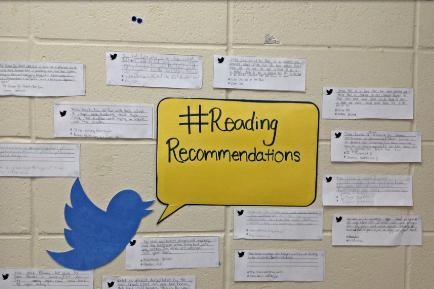
Using Twitter in the classroom
a classroom group twitter account (see step by step guide here) or create a wall display and post book comments (this can be effective if pupils comment regularly during the reading of the book).
3. All in the Family
Where do you read at home? The purpose of this activity is to bring the students’ home culture into the classroom to build community. This project involves asking parents to send a picture via email of their family’s bookshelf, pile of books or a bedroom shelf of books. Students get a glimpse into their classmates’ homes.
3. Classroom library
Providing a variety of reading material is imperative. Aside from novels, comics, graphic novels etc consider adding:
- Tourism brochures
- Newspapers
- Magazines e.g. sports, fishing, 4WD, tech, gardening, National Geographic for Kids, animals etc (a large range can be borrowed from the council library – for free) ** Council librarians are also terrific sources of support and information. A teacher doesn’t need to be solo when it comes to promoting reading and gathering resources.
- Check your shelves at home – do you have any books that you can add? After all, if you’ve read the book you can recommend it to students.
4. Responding to reading
After reading a text/book you might find success with some of these:
- Younger boys can find and write down 5 new words they learned from reading one of the books
- What are some questions you would ask your favourite character if he/she came to dinner?
- Make a bookmark
- Draw the setting of the book
- Reinterpret the illustrations
- Consider getting the students to write reviews on Goodreads or Amazon
- Write postcards/letters to the author or main character
- Book Bingo (great for encouraging kids to read more broadly): Create a bingo chart with things that might appear in a book (e.g. Character fights a dragon; character travels to another country; someone speaks in a different language). Think of a book-related reward for students who reach bingo or check off all the boxes on their sheet.
5. Struggling Readers
| Many years ago, I was tutoring a gorgeous 12-year-old boy who was a reluctant reader and had little confidence when he saw a passage. When I’d asked him what he’d done at school that day, he said that he had had a comprehension test on the Past Queens and Kings of England. (There is no teacher blame here – it’s hard finding boy-centric resources!) This topic was far removed from his interest and knowledge. This was my ‘aha’ moment and led to the creation of Literacy for Boys – writing on topics that boys like and will engage with. I had great success with my students when I wrote comprehension tasks based on rugby, cricket, lego, science, gaming. Draw them into reading using topics that appeal to them. Grammar, punctuation and spelling aren’t earth shakers for kids (yet they are so important!) so that’s why we designed these activities around the above topics (completing a grammar/punctuation/spelling activity about a ghost story/extreme sport/soccer isn’t too unappealing!). |
Quite often the reading materials do not appeal to these readers, their interests, or strengths (and may not have been at an appropriate level for them). As a result, students end up resisting further interactions with books based on their negative past experiences, which leads to fewer literacy skills, which then further intimidates these students from wanting to engage in reading. Hopefully, some of the strategies above will help you know what books would be best for each student.
Our goal is to put books in kids’ hands and spark a genuine interest in reading. We want our students to value literacy for multiple reasons, including academic, personal, and for pleasure. First and foremost, the best way to build reading skills over time is lots of reading.
Check out our blogs for more ideas and tips.
8 Ways to Improve your Child’s Reading Level
Boys Love LFB – Here’s what they have to say!
Get boys reading in the digital age
Why write? Tips for reluctant writers
Brought to you by Tanya Grambower
